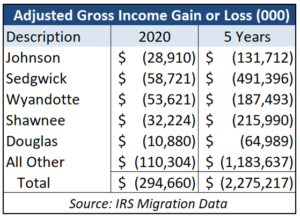Domestic migration data from the IRS shows Kansas lost $295 million in adjusted gross income (AGI) in 2020 because more people left Kansas than moved here. Even Johnson County had a net loss of $28 million that year, capping a 5-year loss of $132 million.
 The IRS defines Adjusted gross income as “gross income minus adjustments to income. Gross income includes your wages, dividends, capital gains, business income, retirement distributions as well as other income. Adjustments to Income include such items as Educator expenses, Student loan interest, Alimony payments or contributions to a retirement account.”
The IRS defines Adjusted gross income as “gross income minus adjustments to income. Gross income includes your wages, dividends, capital gains, business income, retirement distributions as well as other income. Adjustments to Income include such items as Educator expenses, Student loan interest, Alimony payments or contributions to a retirement account.”
Each of the other five largest counties in the state had a net AGI outflow in 2020 and also over the last five years of reported data. Sedgwick County has the largest loss, at $491 million, and Douglas has the least, at $65 million.
The other 100 counties lost $1.2 billion over the five-year period.
AGI loss reflects a weak state economy
Contrary to claims by mainstream media and some candidates for public office, the Kansas economy isn’t doing very well.
Bureau of Economic Analysis data shows real (inflation-adjusted) GDP growth at negative 0.6% for the second quarter of 2022 compared to the first quarter. That earns the Sunflower State a #43 ranking or the 8th-worst in the nation.
Over the last three years (2nd quarter 2019 vs 2nd quarter 2022), real GDP growth in Kansas was an anemic 2.6% or just a little more than half of the 4.8% average for all states.
The Bureau of Labor Statistics also shows Kansas lost 3,400 jobs in August, and there were 33,000 fewer Kansans working than compared to pre-pandemic levels.


